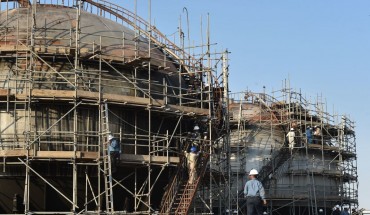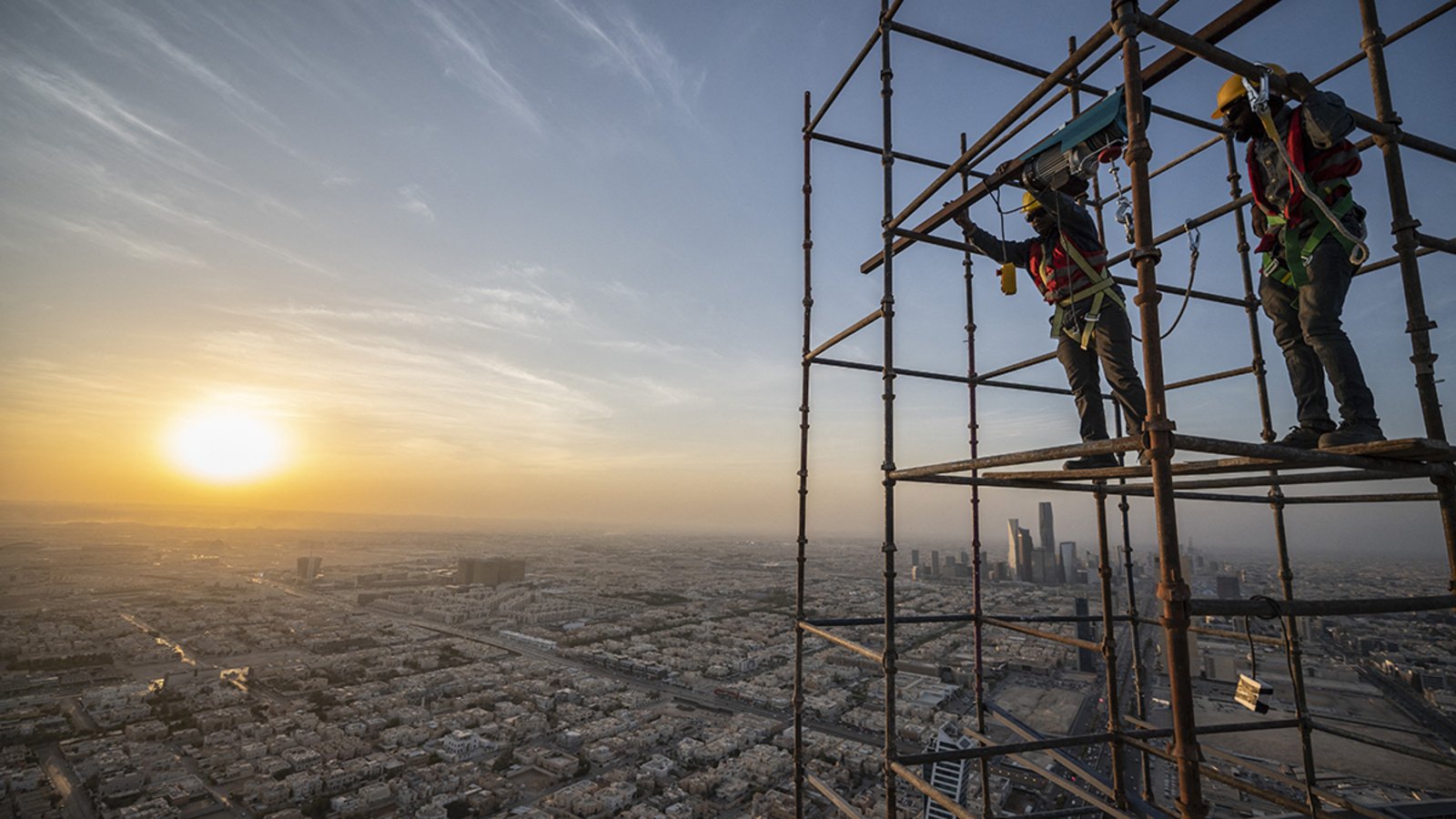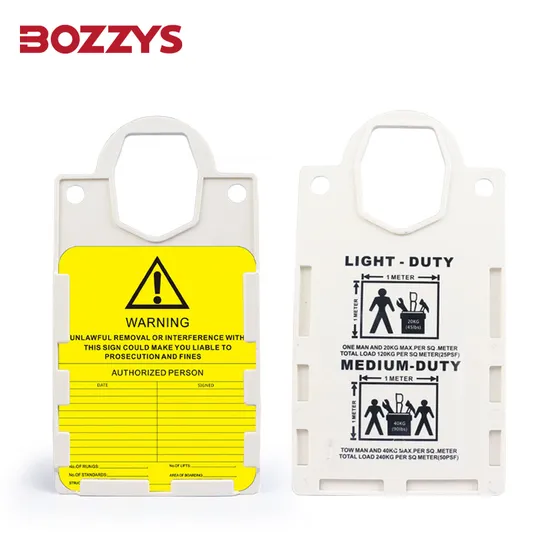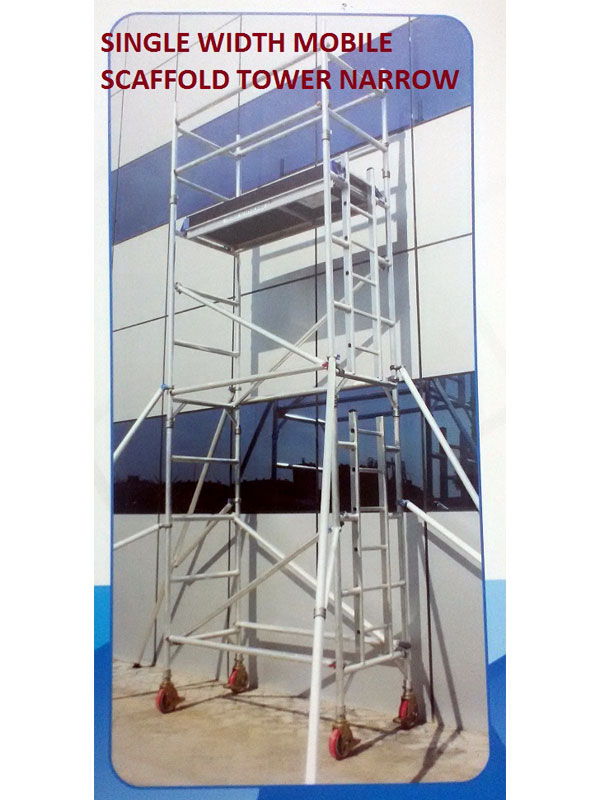Scaffolding is a crucial part of construction projects. It provides workers with a safe platform to perform tasks at various heights.
In Saudi Arabia, construction is booming. With this growth, understanding scaffolding becomes essential. Scaffolding ensures safety and efficiency. It allows workers to reach high places and carry out their work securely. This blog will explore what scaffolding means in the context of Saudi Arabian construction.
We’ll look at its importance and how it supports the industry. You’ll learn about different types of scaffolding and their specific uses. By the end, you will have a clear idea of why scaffolding is vital for construction in Saudi Arabia.

Credit: www.instagram.com
Introduction To Scaffolding
In the vibrant world of construction in Saudi Arabia, scaffolding plays a crucial role. It serves as a temporary structure that supports workers and materials during building projects. Understanding its significance is vital for those involved in construction.
Definition Of Scaffolding
Scaffolding refers to a framework used in construction. It offers support and access to heights. This structure consists of tubes, couplers, and platforms. Workers rely on it to reach areas that are hard to access. Safety is paramount, so scaffolding must be stable and strong.
Importance In Construction
Scaffolding is essential for many reasons. First, it ensures safety for workers at heights. It provides secure platforms for them to work on. Second, it boosts efficiency. Workers can easily reach different parts of a building. This speeds up the construction process.
Lastly, scaffolding supports heavy materials. It helps in the transportation and placement of these materials. This reduces the risk of accidents and injuries. As a result, projects can proceed smoothly and safely.
Types Of Scaffolding
Scaffolding is essential in construction. It provides temporary structures for workers. In Saudi Arabia, various types of scaffolding are used. Each type has unique features and purposes. Understanding these types is crucial for safe construction practices.
Supported Scaffolding
Supported scaffolding is common in Saudi Arabia. It stands on the ground with a solid base. This type is stable and reliable for heavy loads. Builders use it for multi-story projects. Its design allows easy adjustments in height. Safety is a priority in supported scaffolding. Proper installation ensures worker protection.
Suspended Scaffolding
Suspended scaffolding hangs from the top of a building. It uses ropes or wires for support. Workers use it for tall structures and high-rise buildings. This type is flexible and mobile. It allows easy access to building exteriors. Safety harnesses are essential for suspended scaffolding. Proper training minimizes risks during use.
Rolling Scaffolding
Rolling scaffolding is versatile and mobile. It stands on wheels for easy movement. Workers use it for tasks that require frequent relocation. This type is ideal for painting and maintenance jobs. Stability is crucial for rolling scaffolding. Locks on wheels prevent unwanted movement. Regular inspections ensure safe operation.
Materials Used
Scaffolding in Saudi Arabia construction involves using strong materials like steel and aluminum. These materials ensure safety and stability. Wood is also used for platforms, providing a sturdy work surface for workers.
In Saudi Arabia, scaffolding is crucial for construction projects. The materials used in scaffolding can significantly impact the safety and efficiency of the construction process. Understanding these materials can help you make informed decisions on your construction site. ###Metal Scaffolding
Metal scaffolding is widely used due to its strength and durability. It can support heavy loads and withstand harsh weather conditions. This type of scaffolding is often made from steel or aluminum. Steel scaffolding is extremely robust, making it ideal for high-rise buildings. It can be reused multiple times, which makes it cost-effective. However, it is heavy and requires more time to assemble and disassemble. Aluminum scaffolding, on the other hand, is lightweight and easier to handle. It’s perfect for smaller projects or areas where frequent adjustments are needed. While it might not be as strong as steel, its portability and ease of use offer significant advantages. ###Wooden Scaffolding
Wooden scaffolding has been used for centuries and remains popular in certain regions of Saudi Arabia. It’s often made from high-quality timber to ensure stability and safety. One of the main benefits of wooden scaffolding is its flexibility. You can easily cut and shape it to fit specific project needs. This makes it a good option for complex architectural designs. However, wooden scaffolding is less durable than metal. It can be affected by moisture and termites, which may compromise its integrity. Regular inspections and maintenance are crucial to ensure safety when using wooden scaffolding. Choosing the right scaffolding material is essential for the success of your construction project. Do you prefer the strength and durability of metal, or the flexibility and ease of wooden scaffolding? Your choice can make a significant difference in your project’s efficiency and safety.
Credit: www.mei.edu
Scaffolding Regulations In Saudi Arabia
Scaffolding plays a crucial role in construction projects in Saudi Arabia. It ensures workers’ safety and facilitates efficient building processes. The Kingdom has specific regulations for scaffolding to maintain high safety standards. Understanding these regulations is essential for compliance and project success.
Compliance Requirements
All scaffolding must comply with Saudi Arabian standards. Contractors should follow guidelines set by the Ministry of Human Resources and Social Development. Regular inspections are mandatory to ensure structures meet safety protocols. Non-compliance can lead to fines and project delays.
Safety Standards
Safety is a top priority in Saudi construction projects. Scaffolding must be stable and well-maintained. Workers should receive proper training before using scaffolding. Personal protective equipment is essential for all personnel on site. These standards aim to minimize accidents and ensure worker safety.
Safety Measures
Scaffolding is essential in construction, especially in Saudi Arabia, where towering structures are a common sight. Safety measures are crucial when working with scaffolding to protect workers and ensure a smooth construction process. Safety isn’t just a checklist; it’s a mindset that could save lives. Whether you’re a seasoned professional or new to the field, understanding safety measures is vital.
Personal Protective Equipment
Imagine stepping onto a scaffold without a helmet or harness. It’s akin to riding a bike without brakes. Personal Protective Equipment (PPE) is your first line of defense. Helmets protect your head from falling objects, while harnesses prevent falls. Gloves enhance grip and shield your hands from sharp edges. These items are not optional—they’re indispensable.
Have you checked your PPE today? A simple inspection could prevent a mishap. PPE must fit well and be in good condition. Torn or worn-out gear is as good as none. In Saudi Arabia, where temperatures soar, ensure your gear is suitable for extreme conditions. Don’t compromise on your safety.
Regular Inspections
Would you drive a car without checking its brakes? Regular inspections of scaffolding are similarly crucial. Inspecting scaffolding daily can reveal loose bolts, worn-out planks, or signs of rust. These inspections are not just for compliance; they are for your safety.
In Saudi Arabia, construction sites can be bustling with activity, and small issues often get overlooked. Regular inspections help catch these problems early. Engage your team in these inspections. A fresh pair of eyes might spot what you missed. Remember, a well-maintained scaffold is a safe scaffold.
Are you willing to take that extra step for safety? Inspections may seem tedious, but they could be the difference between a safe work environment and a tragedy. When was the last time you inspected your scaffold? Make it a habit, and safeguard your workspace.
Scaffolding Installation Process
Scaffolding plays a crucial role in the construction sector in Saudi Arabia. It ensures safety and efficiency during building projects. The scaffolding installation process is a vital step to guarantee stability and security. This process involves several key stages, each requiring careful attention and precision.
Site Preparation
Preparation begins with assessing the construction site. The site must be cleared of debris and obstacles. This ensures a safe environment for workers. Next, the ground is examined for stability. A stable foundation prevents accidents and enhances safety. Identifying hazards early can minimize risks during the project.
Erecting Scaffolding
Erecting scaffolding involves assembling the structure. This requires skilled workers and precise planning. Workers start by setting up the base. The base supports the entire scaffolding structure. Vertical and horizontal components are then installed. Each piece needs secure fastening to maintain stability. Regular checks ensure components are tightly connected.
Dismantling Procedures
Dismantling scaffolding is as important as erecting it. The process begins with removing the top sections. Workers proceed systematically to avoid accidents. Careful disassembly prevents damage to equipment. Each part is carefully stored for future use. Proper dismantling ensures site cleanliness and safety.
Common Challenges
Scaffolding in construction in Saudi Arabia faces common challenges. Ensuring worker safety and meeting strict regulations are top concerns. Harsh weather conditions also impact scaffold stability.
When it comes to construction in Saudi Arabia, scaffolding plays a crucial role in ensuring the safety and efficiency of the building process. However, it isn’t without its challenges. Understanding these common hurdles can help you navigate and mitigate potential risks, leading to smoother operations on-site. Let’s dive into some of these challenges, focusing on two key aspects: weather conditions and material quality.Weather Conditions
Saudi Arabia is known for its extreme weather, ranging from scorching heat to unexpected sandstorms. Such conditions can significantly impact scaffolding stability and worker safety. Imagine trying to secure scaffolding when a sudden gust of wind threatens to topple it over. You need to ensure that scaffolding is properly anchored and regularly inspected, especially after severe weather events. The heat can also affect the materials, making them prone to wear and tear. Regular maintenance and adapting work schedules to cooler times of the day can help in managing these weather challenges effectively.Material Quality
The quality of scaffolding materials is another critical concern. Low-quality materials may save costs upfront but can lead to accidents and increased long-term expenses. Consider the implications of a scaffold collapsing due to substandard materials; the financial and human costs are too high. Ensure that you source scaffolding from reputable suppliers who adhere to international safety standards. Checking the quality of the materials before purchase and conducting regular inspections can prevent potential hazards. Investing in high-quality materials may seem costly at first, but it pays off in safety and reliability. Have you ever thought about the long-term impact of choosing the right scaffolding? The decisions you make today can significantly influence the safety and success of your construction projects in Saudi Arabia. By addressing these challenges head-on, you’re not just building structures; you’re building a safer future.
Credit: www.cfr.org
Future Trends
Future Trends in Scaffolding Construction in Saudi Arabia
Scaffolding in Saudi Arabia is not just a temporary structure anymore. It’s evolving into a sophisticated system that shapes the future of construction. As you look at the horizon, technological advancements and sustainability initiatives are leading the charge. Imagine scaffolding systems that are smarter, greener, and more efficient. These changes are not just about building; they’re about transforming the landscape of construction.
Technological Advancements
Technology is reshaping scaffolding like never before. Digital tools and software are making it easier to design and manage scaffolding systems. You can now simulate scaffolding setups before actual construction. This ensures safety and efficiency right from the start.
3D modeling is another game-changer. It allows you to visualize the scaffold in detail. This reduces errors and enhances the precision of construction projects. The use of drones for inspection is also gaining traction. Imagine being able to monitor every corner of the scaffold without climbing a ladder.
Sustainability Initiatives
Saudi Arabia is embracing sustainability in scaffolding. Eco-friendly materials are becoming popular in scaffolding construction. Steel, which is recyclable, is often preferred for its durability and environmental benefits.
Energy-efficient methods are also on the rise. Solar-powered scaffolding lights ensure that work can continue efficiently while reducing carbon footprints. You might wonder how these changes impact the cost. Surprisingly, sustainable practices often lead to long-term savings.
As these trends unfold, you have the chance to be part of a construction revolution. How will you adapt to these changes? Will you embrace the new technologies and sustainable methods? Your choices today will shape the future of scaffolding in Saudi Arabia.
Frequently Asked Questions
What Is The Meaning Of Scaffolding In Construction?
Scaffolding in construction refers to temporary structures used to support workers and materials during building or repair tasks. It ensures safety and access to high areas. Scaffolding includes platforms, ladders, and guardrails, allowing efficient work at various heights. Proper setup and maintenance are crucial for worker safety.
What Is The Salary Of Scaffolding Engineer In Saudi Arabia?
A scaffolding engineer in Saudi Arabia typically earns between SAR 8,000 and SAR 15,000 monthly. Salaries depend on experience, skills, and company size.
What Are The Three 3 Types Of Scaffolding?
The three types of scaffolding are supported scaffolding, suspended scaffolding, and rolling scaffolding. Supported scaffolding uses poles or frames. Suspended scaffolding hangs from ropes or chains. Rolling scaffolding features wheels for mobility. Each type serves specific construction or maintenance needs.
Choose based on project requirements and safety standards.
What Is The Scaffolding In Construction Process?
Scaffolding provides temporary support and access during construction. It consists of platforms, tubes, and couplers. Workers use scaffolding for elevated tasks safely. It ensures stability and efficiency in building processes. Scaffolding is essential for construction safety standards and project success.
Conclusion
Scaffolding plays a crucial role in Saudi Arabian construction. It ensures safety and efficiency. Workers can reach high places easily. Projects finish faster with proper scaffolding. Understanding its importance helps everyone involved. Safer construction sites benefit all. Proper scaffolding practices prevent accidents.
It supports workers and heavy materials. Essential for building strong structures. The right scaffolding contributes to successful projects. Always prioritize safety in construction.


